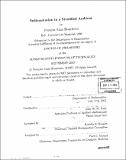| dc.contributor.advisor | John W.M. Bush. | en_US |
| dc.contributor.author | Blanchette, François Alain, 1978- | en_US |
| dc.contributor.other | Massachusetts Institute of Technology. Dept. of Mathematics. | en_US |
| dc.date.accessioned | 2006-03-24T18:09:19Z | |
| dc.date.available | 2006-03-24T18:09:19Z | |
| dc.date.copyright | 2003 | en_US |
| dc.date.issued | 2003 | en_US |
| dc.identifier.uri | http://hdl.handle.net/1721.1/29986 | |
| dc.description | Thesis (Ph. D.)--Massachusetts Institute of Technology, Dept. of Mathematics, 2003. | en_US |
| dc.description | Includes bibliographical references (p. 147-156). | en_US |
| dc.description.abstract | We study the interaction between settling particles and a stratified ambient in a variety of contexts. We first study the generation of large scale fluid motions by the localised release of a finite mass of particles in the form of plumes or gravity currents. We present the results of a combined theoretical and experimental study describing the evolution of particle clouds formed by the release of heavy particles. In the early stages of motion, particle clouds behave as turbulent fluid thermals; however, their radial expansion eventually stops and particles settle from the base of the cloud at their individual settling speed. We focus on deducing a criterion for the various modes of particle deposition from particle clouds in a stratified ambient. We proceed to study the deposition patterns resulting from particle-laden gravity currents that spread horizontally when released in a particle-free ambient. Using a box-model, we focus on bidisperse gravity currents and examine the resulting particle distribution and maximal deposit length. We then turn to suspensions where particles are initially present throughout the fluid. The simultaneous presence of particles and of a stratified ambient may lead to behaviour analogous to double-diffusive systems, with particles playing the role of a diffusing component. We examine the linear stability of the settling of a particle concentration gradient in a stratified fluid. Numerical simulations allow us to determine the stability of the system for a broad range of particle settling speeds and diffusion coefficients. We then report on layering arising from sedimentation in a density stratified ambient beneath an inclined wall. | en_US |
| dc.description.abstract | (cont.) From our experimental study, we describe the series of horizontal intrusions formed by particle-free fluid intruding at its level of neutral buoyancy. We present numerical models describing the time evolution of the concentration of particles and the layer formation. Finally, we present an experimental and theoretical study of the combined influence of hindered settling and settling speed variations due to an ambient stratification. We develop a criterion for the stability of a suspension settling in a stratified ambient and experimental observations allow us to qualify the main features of this instability. | en_US |
| dc.description.statementofresponsibility | by François Alain Blanchette. | en_US |
| dc.format.extent | 156 p. | en_US |
| dc.format.extent | 9058908 bytes | |
| dc.format.extent | 9058717 bytes | |
| dc.format.mimetype | application/pdf | |
| dc.format.mimetype | application/pdf | |
| dc.language.iso | eng | en_US |
| dc.publisher | Massachusetts Institute of Technology | en_US |
| dc.rights | M.I.T. theses are protected by copyright. They may be viewed from this source for any purpose, but reproduction or distribution in any format is prohibited without written permission. See provided URL for inquiries about permission. | en_US |
| dc.rights.uri | http://dspace.mit.edu/handle/1721.1/7582 | |
| dc.subject | Mathematics. | en_US |
| dc.title | Sedimentation in a stratified ambient | en_US |
| dc.type | Thesis | en_US |
| dc.description.degree | Ph.D. | en_US |
| dc.contributor.department | Massachusetts Institute of Technology. Department of Mathematics | |
| dc.identifier.oclc | 54790946 | en_US |
